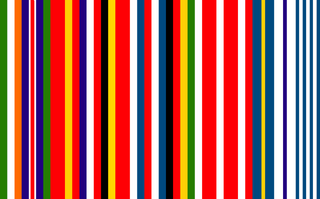vorschlag für eine europäische flagge von rem koolhaas (2001)

The barcode has been featured in a number of prominent European newspapers, mistakenly touting it as the new European flag to replace the current twelve gold stars. This, however, was certainly not the idea behind its conception. The barcode was merely a suggestion for an extra symbol, parallel to the existing EU symbols, to bring Europe in a new way to new audiences. The joining of ten new members to the EU in 2004 resulted in a first official 'update'of the barcode. The Austrian EU Presidency of 2006 marked the first official use of the barcode. AMO designed the visual identity for the Austrian EU Presidency that took place from January 2006 – July 2006. The design, which is based on the barcode, resulted in various 'barcoded' items ranging from coffee mugs to trains and was prominently used at various summit meetings.
Since the time of the first drafts of the barcode it has very rarely been officially used by commercial or political institutions. During the Austrian EU Presidency 2006, it was officially used for the first time. The logo was used for the EU information campaign, but was very negatively criticized. In addition to the initially uproar caused by the Estonian flag stripes displayed incorrectly, the proposed flag failed to achieve its main objective as a symbol. Critics pointed the lack of capability to relate the signified (the mental concept, the European Union) with the signifier (the physical image, the stripes) as the major problem, as well as the presented justification for the order in which the color stripes were displayed (as every country in the EU should be regarded as equal in importance and priority).
The European Republic is under construction.